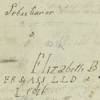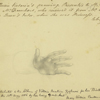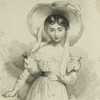Epilogue: The Youngest Romantics
 Sebastian, or Virtue
Sebastian, or Virtue
Rewarded
NYPL,
Berg
Collection
 Queen
Victoria's
Queen
Victoria's
pencil
drawing
of
hand, ca. 1830
NYPL,
Pforzheimer
Collection
 Her Highness
the
Her Highness
the
Princess
Victoria
NYPL, Print Collection
![[Mary Wollstonecraft]](images/sqthumb/ps_cps_cd6_081.jpg)
[Mary Wollstonecraft]
NYPL,
Pforzheimer
Collection
The women of this last section came of age at the end of the Romantic
era; their lives offer a glance at the transition to the Victorian period.
Where poetry had been the most esteemed and popular form among readers
of a generation before, the novel was now the most-read genre. The publishing
business boomed as new methods of making paper resulted in cheaper books
and magazines. Indeed, all of Britain—except for Ireland—was
booming, in its industry, its population, its overseas empire. And in
the magazines, the topics of debate reflected this boom: child labor,
factory conditions, "scientific" racism, prostitution, conditions
in the colonies. It was a larger world altogether, with starker differences
between people.
Expectations of women’s sexuality had changed, too: convention
had forced Mary Wollstonecraft to pretend that Gilbert Imlay was her
husband, but George Eliot lived openly with her life partner, George
Henry Lewes. In Wollstonecraft’s London, women were assumed to
be the same lustful creatures as men, and even respectable newspapers
printed gossip. In the larger, smokier, more secretive London of the
mid-nineteenth century, it was easier for women to live independently,
lost in the crowd. Within their families, however, social demands were
more stringent, and middle-class women were assumed to be "pure"—that
is, passionless. Women of the period before Victoria, their longings
unsuppressed, seem more familiar to us. And while the past is not a mirror
for the present, the strivings of these women—like Princess Victoria’s
beautifully drawn outstretched hand, on view here—reflect the still
unrealized plans that are their legacy.




![[Mary Wollstonecraft]](images/sqthumb/ps_cps_cd6_081.jpg)